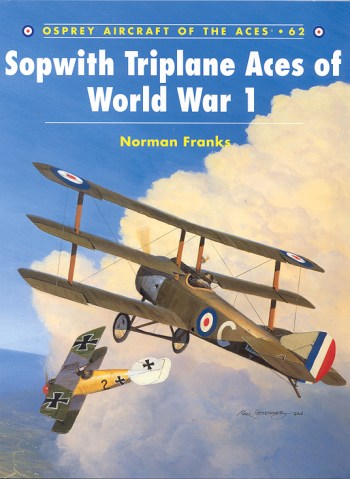 Osprey
has really hit it big on their various series of books and none has done
better than their Aces series. This particular book is #62 and covers
Sopwith Triplane Aces of WWI. These men are in a rather elite grouping as
there were not that many Sopwith Triplanes built; some estimates being that
there were less than 200 aircraft actually constructed.
Osprey
has really hit it big on their various series of books and none has done
better than their Aces series. This particular book is #62 and covers
Sopwith Triplane Aces of WWI. These men are in a rather elite grouping as
there were not that many Sopwith Triplanes built; some estimates being that
there were less than 200 aircraft actually constructed.
However, the aircraft had several advantages over the
German Albatros D.III fighters of the time. One was that the thinner wings
offered better pilot vision over the standard biplane. Another is that,
with three wings providing lift, it was able to climb much better than its
opponents and this additional lifting surface also imparted excellent
maneuverability. There are several pilot stories about flying the Sopwith
Triplane and to a man they all commented on how easy an aircraft it was to
fly; unlike the much more difficult Sopwith Camel that was to come a bit
later.
Downside of the aircraft was that it was armed with only
one gun in a time when the Germans had two. Another was that it was
reported to be quick to shed wings in a dive. When the more powerful 130 hp
engine was put into the aircraft, some were modified to carry twin guns
while a few pilots added additional rigging to help keep the wings on it.
The aircraft was operated entirely by the RNAS and despite
being in combat for only a few months (such was the speed of aviation
development), it enabled a number of pilots to achieve a stunning string of
victories against the enemy. Probably the most well-known of those pilots
was Raymond Collishaw, who flew with 10 Sq RNAS and was leader of the
famous 'Black Flight' where all the aircraft were prefixed with 'Black'. He
was also the top scoring Triplane ace with 34 of his 60 victories scored in
this aircraft, many in his aircraft named 'Black Maria'. Unknown to this
reader was that the French also operated a handful of Triplanes, but
apparently they were not as successful with it as the British.
As with all the 'Aces' books, this one has a full listing
of pilots and squadrons as well as a healthy number of color profiles and a
very nice three-view drawing of the aircraft. There are also a goodly
number of quality period photographs of the men and aircraft. It is a book
that, once you start reading, you can't put down. Highly recommended.
Available in bookstores everywhere, through Classic
Motorbooks at (800) 826-6600 or at
www.motorbooks.com. For more on the complete line of Osprey books,
visit www.ospreypublishing.com
If you would like your product reviewed fairly and quickly by a
site that has nearly 250,000 visitors a month, please contact
me or see other details in the Note to
Contributors.
 Osprey
has really hit it big on their various series of books and none has done
better than their Aces series. This particular book is #62 and covers
Sopwith Triplane Aces of WWI. These men are in a rather elite grouping as
there were not that many Sopwith Triplanes built; some estimates being that
there were less than 200 aircraft actually constructed.
Osprey
has really hit it big on their various series of books and none has done
better than their Aces series. This particular book is #62 and covers
Sopwith Triplane Aces of WWI. These men are in a rather elite grouping as
there were not that many Sopwith Triplanes built; some estimates being that
there were less than 200 aircraft actually constructed.